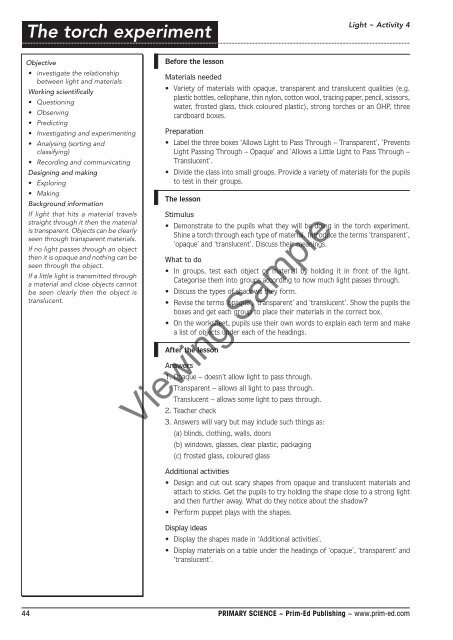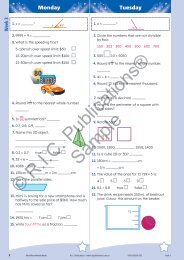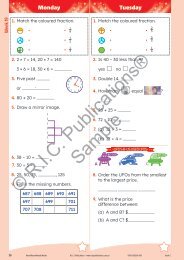PR-0552UK Primary Science - Book 2
Create successful ePaper yourself
Turn your PDF publications into a flip-book with our unique Google optimized e-Paper software.
The torch experiment<br />
Light ~ Activity 4<br />
Objective<br />
• investigate the relationship<br />
between light and materials<br />
Working scientifically<br />
• Questioning<br />
• Observing<br />
• Predicting<br />
• Investigating and experimenting<br />
• Analysing (sorting and<br />
classifying)<br />
• Recording and communicating<br />
Designing and making<br />
• Exploring<br />
• Making<br />
Background information<br />
If light that hits a material travels<br />
straight through it then the material<br />
is transparent. Objects can be clearly<br />
seen through transparent materials.<br />
If no light passes through an object<br />
then it is opaque and nothing can be<br />
seen through the object.<br />
If a little light is transmitted through<br />
a material and close objects cannot<br />
be seen clearly then the object is<br />
translucent.<br />
Before the lesson<br />
Materials needed<br />
• Variety of materials with opaque, transparent and translucent qualities (e.g.<br />
plastic bottles, cellophane, thin nylon, cotton wool, tracing paper, pencil, scissors,<br />
water, frosted glass, thick coloured plastic), strong torches or an OHP, three<br />
cardboard boxes.<br />
Preparation<br />
• Label the three boxes ‘Allows Light to Pass Through – Transparent’, ‘Prevents<br />
Light Passing Through – Opaque’ and ’Allows a Little Light to Pass Through –<br />
Translucent’.<br />
• Divide the class into small groups. Provide a variety of materials for the pupils<br />
to test in their groups.<br />
The lesson<br />
Stimulus<br />
• Demonstrate to the pupils what they will be doing in the torch experiment.<br />
Shine a torch through each type of material. Introduce the terms ‘transparent’,<br />
‘opaque’ and ‘translucent’. Discuss their meanings.<br />
What to do<br />
• In groups, test each object or material by holding it in front of the light.<br />
Categorise them into groups according to how much light passes through.<br />
• Discuss the types of shadows they form.<br />
• Revise the terms ‘opaque’, ‘transparent’ and ‘translucent’. Show the pupils the<br />
boxes and get each group to place their materials in the correct box.<br />
• On the worksheet, pupils use their own words to explain each term and make<br />
a list of objects under each of the headings.<br />
After the lesson<br />
Answers<br />
1. Opaque – doesn’t allow light to pass through.<br />
Transparent – allows all light to pass through.<br />
Translucent – allows some light to pass through.<br />
2. Teacher check<br />
3. Answers will vary but may include such things as:<br />
(a) blinds, clothing, walls, doors<br />
(b) windows, glasses, clear plastic, packaging<br />
(c) frosted glass, coloured glass<br />
Viewing Sample<br />
Additional activities<br />
• Design and cut out scary shapes from opaque and translucent materials and<br />
attach to sticks. Get the pupils to try holding the shape close to a strong light<br />
and then further away. What do they notice about the shadow?<br />
• Perform puppet plays with the shapes.<br />
Display ideas<br />
• Display the shapes made in ‘Additional activities’.<br />
• Display materials on a table under the headings of ‘opaque’, ‘transparent’ and<br />
‘translucent’.<br />
44 <strong>PR</strong>IMARY SCIENCE ~ Prim-Ed Publishing ~ www.prim-ed.com


















